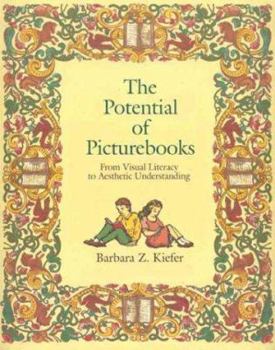The Potential of Picture Books: From Visual Literacy to Aesthetic Understanding
Select Format
Select Condition 
Book Overview
Book by Kiefer, Barbara Z. This description may be from another edition of this product.
Format:Paperback
Language:English
ISBN:0023635355
ISBN13:9780023635359
Release Date:January 1994
Publisher:Pearson
Length:320 Pages
Weight:1.50 lbs.
Dimensions:0.8" x 8.0" x 10.0"
Customer Reviews
1 rating
The Potential of Picturebooks: From Visual Literacy to Aesthetic Understanding
Published by Thriftbooks.com User , 16 years ago
Kiefer, Barbara Z. 1995. The potential of picturebooks: From visual literacy to aesthetic understanding. Englewood Cliffs, N.J.: Prentice Hall, Inc. ISBN: 0-02-363535-5. Barbara Kiefer combined her love for children's literature with her studies in art to produce The Potential of Picturebooks. This book "offers a variety of avenues for exploring the potential of the picture book." (p. iv). It is divided into three parts. Part I, "Children and Picture Books", includes three chapters. The first chapter surveys and discusses research on the role picture books have on children's literacy. This meaty chapter presents many different researches and viewpoints regarding just how picture books influence children's literacy skills. Ultimately, Ms. Kiefer asserts that children are meaning makers and picture books are a rich resource for both intellectual and emotional meaning. Chapter Two covers how children look at, respond to, and talk about picture books. Children use four different types of languages, informative, heuristic, imaginative and personal, while discussing picturebooks. Each language is defined, and there are excerpts from the children's dialogue. These excerpts give readers an opportunity to hear examples of each language and to understand how these languages co-mingle in the children's discussions. After researching children's responses, Ms. Kiefer concludes that they have an uncanny intuition about elements of artistic style. Chapter Three identifies research based practices that support children's reflection and how they make sense of what they read. Ms. Kiefer explains that first children need an adult who will introduce books that the child might not ordinarily choose independently, and then "allow time for those deep understandings to rise to the surface of their consciousness." (p.55). Other contributing factors are: an enthusiastic teacher who offers a variety of books in the classroom, actively promotes books, and sets up special reading spaces in the classroom. Chapter Three chapter also includes dialogue among the teacher and students. These dialogue excerpts clearly demonstrate how effective teachers both question and actively listen to students in order to extend visual literacy to aesthetic understanding. Part II, "The Art of the Picturebook", offers an overview of the historical, technical creation, and style of picture books so that one may "explore the potential of the picture book as an art object." (p. 70). Chapter 4 delves into the history of the picture book with a focus on the inner need of humans to express emotional and intellectual experiences through paintings. Chapter 5 describes the process of creating picture books and then extends the technical aspects with comments from contemporary authors/illustrators. Maurice Sendak, Tomie dePaola, John Steptoe, and Trina Schart Hyman discuss their goals of art in picture books. Chapter 6 reflects on how the style of the illustrations impact the text of the picture book






